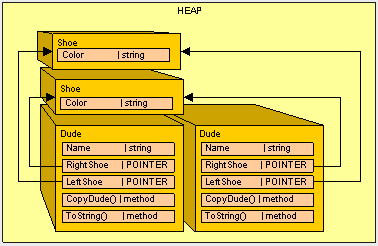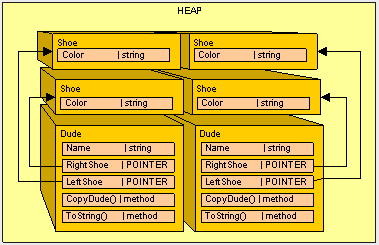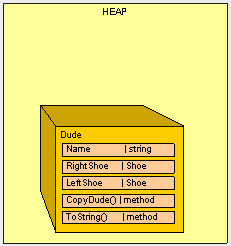[译文]C# Heap(ing) Vs Stack(ing) in .NET: Part III
原文地址:http://www.c-sharpcorner.com/UploadFile/rmcochran/chsarp_memory401152006094206AM/chsarp_memory4.aspx
A Copy Is Not A Copy
为了清楚的说明这个问题,我们来校验以下两种情形将会发生什么情况:位于堆里面的一个值类型和位于堆里面的一个引用类型。我们先看值类型。看下面的class和struct。我们有一个Dude类,该类包含一个Name元素和两个Shoe(s)。同时,添加一个CopyDude()方法来更加方便的new Dudes.
public struct Shoe{
public string Color;
}
public class Dude
{
public string Name;
public Shoe RightShoe;
public Shoe LeftShoe;
public Dude CopyDude()
{
Dude newPerson = new Dude();
newPerson.Name = Name;
newPerson.LeftShoe = LeftShoe;
newPerson.RightShoe = RightShoe;
return newPerson;
}
public override string ToString()
{
return (Name + " : Dude!, I have a " + RightShoe.Color +
" shoe on my right foot, and a " +
LeftShoe.Color + " on my left foot.");
}
}我们的Dude是一个引用类型,但是Shoe是一个结构体,属于值类型,在堆栈上的反应是这样的:
当我们执行以下方法的时候:
public static void Main()
{
Class1 pgm = new Class1();
Dude Bill = new Dude();
Bill.Name = "Bill";
Bill.LeftShoe = new Shoe();
Bill.RightShoe = new Shoe();
Bill.LeftShoe.Color = Bill.RightShoe.Color = "Blue";
Dude Ted = Bill.CopyDude();
Ted.Name = "Ted";
Ted.LeftShoe.Color = Ted.RightShoe.Color = "Red";
Console.WriteLine(Bill.ToString());
Console.WriteLine(Ted.ToString());
}
我们得到了预期的结果:
Bill : Dude!, I have a Blue shoe on my right foot, and a Blue on my left foot.
Ted : Dude!, I have a Red shoe on my right foot, and a Red on my left foot.
如果我们把Shoe改成引用类型,会是怎样一种情况呢?问题就在于此。我们将Shoe改成引用类型(class):
public class Shoe{
public string Color;
}
让后再次执行Main()方法,我们得到的结果是:
Bill : Dude!, I have a Red shoe on my right foot, and a Red on my left foot
Ted : Dude!, I have a Red shoe on my right foot, and a Red on my left foot
注意到红色部分,这显然是一个错误。这是我们在堆里面得到的结果:

由于我们现在使用Shoe作为引用类型而不是值类型,而,当我们拷贝引用类型的内容时,我们只是拷贝了指针。我们必须做一些额外的工作,让我们的引用类型看起来更像是值类型。
幸运的是,我们有一个接口可以帮助我们解决这个问题:ICloneable。这个接口是所有的Dudes都遵守的契约,并且定义了一个应用类型是如何复制的,以防止我们的”共享鞋(shoe sharing)”的错误。所有的类要能被clone,都需要实现ICloneable接口,我们的Shoe也不例外。
ICloneable包含一个方法:Clone():
public object Clone()
{
}
我们将Shoe类改成如下:
public class Shoe : ICloneable
{
public string Color;
#region ICloneable Members
public object Clone()
{
Shoe newShoe = new Shoe();
newShoe.Color = Color.Clone() as string;
return newShoe;
}
#endregion
}
在Clone方法中,我们只是new了一个Shoe,克隆了所有的引用类型和拷贝了所有的值类型,然后返回一个新的object。也许你已经注意到了,string已经实现了ICloneable,因此我们可以直接调用Color.Clone()。由于Clone()方法是返回引用类型的,因此,在我们设定shoe的color之前我们必须重新设定引用的类型(retype the reference).
下一步,在我们的CopyDude()方法中,我们需要克隆shoes而不是拷贝他们:
public Dude CopyDude()
{
Dude newPerson = new Dude();
newPerson.Name = Name;
newPerson.LeftShoe = LeftShoe.Clone() as Shoe;
newPerson.RightShoe = RightShoe.Clone() as Shoe;
return newPerson;
}
现在,当我们运行Main()方法:
public static void Main()
{
Class1 pgm = new Class1();
Dude Bill = new Dude();
Bill.Name = "Bill";
Bill.LeftShoe = new Shoe();
Bill.RightShoe = new Shoe();
Bill.LeftShoe.Color = Bill.RightShoe.Color = "Blue";
Dude Ted = Bill.CopyDude();
Ted.Name = "Ted";
Ted.LeftShoe.Color = Ted.RightShoe.Color = "Red";
Console.WriteLine(Bill.ToString());
Console.WriteLine(Ted.ToString());
}
我们得到的结果:
Bill : Dude!, I have a Blue shoe on my right foot, and a Blue on my left foot
Ted : Dude!, I have a Red shoe on my right foot, and a Red on my left foot
这正是我们需要的:

将东西包装起来(Wrapping Things Up)
作为通常的情况,我们总是想要克隆引用类型和拷贝值类型。(这将减少你为了防止头疼而不得不买的阿司匹林,当你调试这些错误的时候)
为了减少令人头痛的事,让我们更进一步,来整理Dude类,使它是想ICloneable,而不是使用CopyDude()方法。
public class Dude: ICloneable
{
public string Name;
public Shoe RightShoe;
public Shoe LeftShoe;
public override string ToString()
{
return (Name + " : Dude!, I have a " + RightShoe.Color +
" shoe on my right foot, and a " +
LeftShoe.Color + " on my left foot.");
}
#region ICloneable Members
public object Clone()
{
Dude newPerson = new Dude();
newPerson.Name = Name.Clone() as string;
newPerson.LeftShoe = LeftShoe.Clone() as Shoe;
newPerson.RightShoe = RightShoe.Clone() as Shoe;
return newPerson;
}
#endregion
}
我们也需要修改Main()方法来使用Dude.Clone():
public static void Main()
{
Class1 pgm = new Class1();
Dude Bill = new Dude();
Bill.Name = "Bill";
Bill.LeftShoe = new Shoe();
Bill.RightShoe = new Shoe();
Bill.LeftShoe.Color = Bill.RightShoe.Color = "Blue";
Dude Ted = Bill.Clone() as Dude;
Ted.Name = "Ted";
Ted.LeftShoe.Color = Ted.RightShoe.Color = "Red";
Console.WriteLine(Bill.ToString());
Console.WriteLine(Ted.ToString());
}
我们最后的输出是:
Bill : Dude!, I have a Blue shoe on my right foot, and a Blue on my left foot.
Ted : Dude!, I have a Red shoe on my right foot, and a Red on my left foot.
一切都正常。
一些值得注意的有趣的事是System.String的赋值操作(=操作符)事实上克隆了string,所以你不必担心重复的引用。然而,你需要注意防止内存膨胀。如果你看了上面的图标,由于string是一个引用类型,它需要指向堆里的另外一个对象,但为了简单,它显示成一个值类型。
总结:
通常的,如果我们有打算拷贝我们的对象,我们需要实现ICloneable。这样可以使我们的引用类型在行为上看起来有点像值类型。正如你所看到的,记录我们正在处理的是那种类型变量是很重要的,因为值类型和引用类型在分配内存时是不一样的。
待续…




